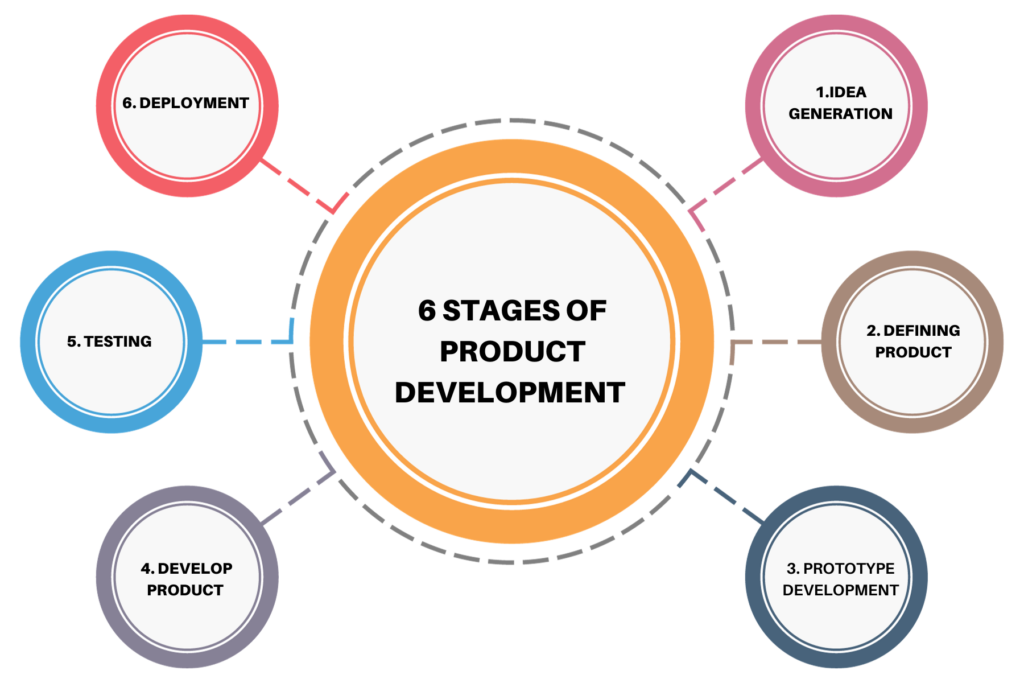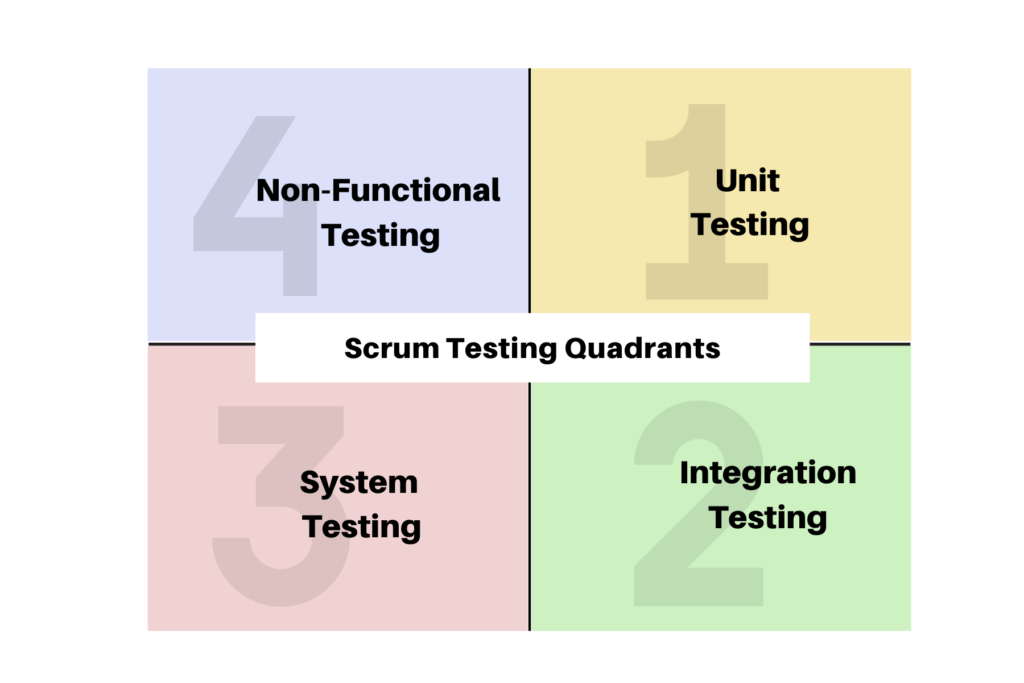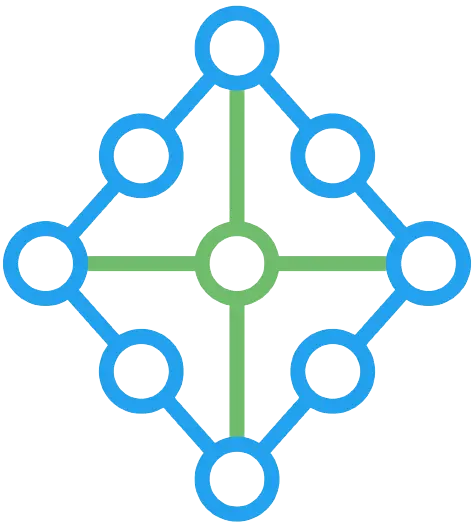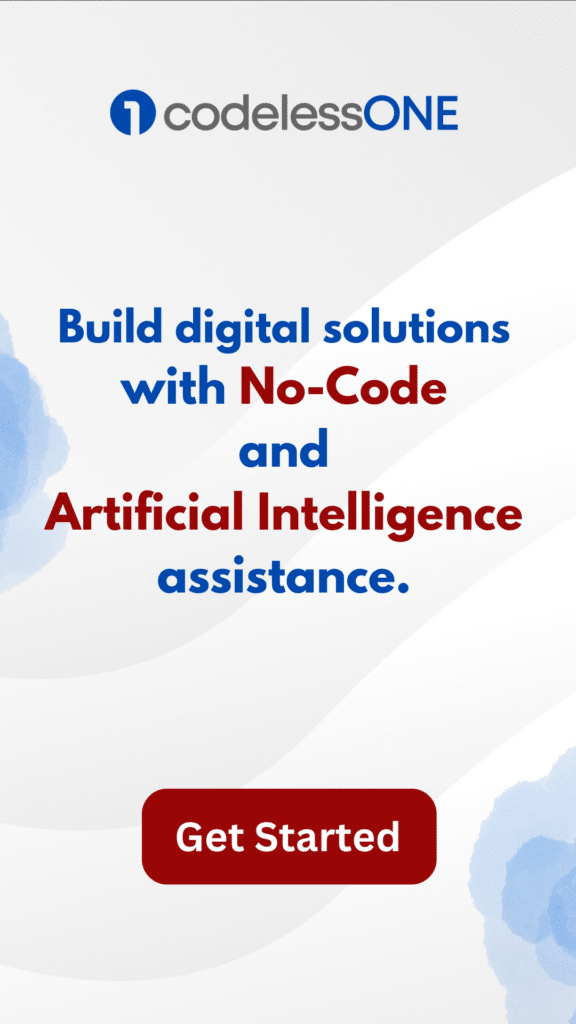Step by Step Guide -
6 Stages of
Product Development Process.
Share:

Table of Contents
Have you ever found yourself curious about the intricate process that brings your favorite digital solutions to your screens? How do these ingenious creations evolve from concepts to user-friendly, must-have applications? Prepare to delve deep into the world of digital product development. In this blog post, we’ll share the crucial steps and 6 stages that transform product ideas into seamless digital experiences?
What is product development?
Product development is a comprehensive that initiates with idea generation, followed by meticulous market research and rigorous feasibility analysis, assessing technical, financial, and operational aspects. The development phase entails precise product design, prototype creation, and actual application construction, with stringent testing and quality assurance protocols to ensure adherence to performance, functionality, and safety standards. Subsequently, prototypes or beta versions may undergo real-world testing with limited users. The product is officially launched upon finalization, and continuous post-launch evaluation, informed by customer feedback and market performance, drives refinements, updates, and issue resolution to maintain competitiveness and innovation.
What are 6 stages of product development process?
Product development process comprises of six distinct stages, each with its unique significance in shaping innovative solutions.

1. Idea Generation
Idea generation is about forming the foundation for innovative and successful products. Brainstorming is a creative and collaborative process that can be incredibly valuable for generating product idea.
Start by articulating the problem or challenge you want to address with your product development. Make sure all participants and stakeholders understand the problem and its context.
Here are some popular brainstorming techniques to stimulate idea generation:
- Mind mapping: Create visual representations of ideas and their connections.
- Reverse brainstorming: Think of ways to cause the problem instead of solving it, then flip those product ideas to find solutions.
- SCAMPER: Use this acronym (Substitute, Combine, Adapt, Modify, Put to another use, Eliminate, Reverse) to prompt creative thinking.
2. Product Definition and Concept Development
The product-defining stage is where you solidify your product concept and establish a clear direction for the development effort. It involves defining the product’s purpose, features, functionality, target audience, and overall strategy.
Market Research: Conduct comprehensive market research and business analysis to understand your target market, competition, and industry trends. Identify your potential customers’ pain points and needs and assess how your product can address them effectively.
Defining Objectives: Clearly define the objectives and goals for your product. What do you want to achieve with this product? Are you looking to increase revenue, capture market share, solve a specific problem, or build a work management application?
Development Timeline: Create a development timeline with milestones and deadlines—factor in dependencies, resource availability, and potential risks.
Budgeting: Estimate the budget required for product development, including personnel, technology, marketing, and other associated costs.
Risk Assessment: Identify potential risks and challenges hindering the development process. Develop contingency plans and mitigation strategies to address these risks.
Legal and Compliance Considerations: Ensure your product complies with relevant laws, regulations, and industry standards. Address issues like data privacy, intellectual property, and required certifications or licenses.
Documentation: Maintain thorough documentation throughout this stage, including a Product Requirements Document (PRD) that outlines all the details of the product concept. PRD is a comprehensive and essential document used in the product development process to outline a product’s specifications, features, functionalities, and objectives. It serves as a blueprint that guides the development team in building the product according to the defined specifications and aligns stakeholders on the application’s goals.
3. Prototype Development
Creating a prototype is most important in product development as it allows you to visualize and test your concept before investing in full-scale development. Depending on your needs, you can choose from the following types of Prototypes.
High-Fidelity Prototypes:
High-fidelity prototypes closely resemble the final application or application in terms of design, functionality, and interactivity. They gather detailed feedback on the user experience and design elements. Tools like Codeless ONE are used to create high-fidelity prototypes rapidly.
Clickable Prototypes:
Clickable prototypes are interactive representations of a product’s user interface. They allow users to click through screens or elements to simulate the user experience. Tools like InVision, Figma, or Adobe XD are used to create clickable prototypes.
HTML/CSS Prototypes:
These prototypes involve coding basic HTML and CSS to create a functional, web-based prototype. They are more advanced than clickable prototypes and may incorporate limited functionality. However, in the modern era, a lot of time, money and effort is saved by using AI and No-Code for creating prototypes.
Wireframe Prototypes:
Wireframes are basic, static, and often grayscale user interface representations. They focus on layout and content placement and are commonly used to outline the structure of web pages or mobile apps. Due to the availability of no-code tools for building fully functional prototypes, the usability of wireframing has reduced over time.
4. Product Development
Different product development strategies and practices are employed based on project requirements, team dynamics, and industry standards. Here are some commonly used development strategy and coding methods:
- No-Code Development: No-code platforms democratize software development, enabling non-technical users to create custom applications, while AI augments these solutions with data-driven insights, automation, and enhanced user experiences. Together, they accelerate innovation, reduce development costs, improve efficiency, and unlock new opportunities across industries, making technology more accessible and impactful than ever before. Check out No-Code trends and predictions and get your products to market faster
- Agile Development: Agile is a widely adopted development approach that focuses on flexibility, collaboration, and customer feedback. It emphasizes iterative development and involves breaking the project into smaller, manageable units called sprints. Agile methodologies, including Scrum and Kanban, promote adaptability, continuous improvement, and customer-centric development.
- Waterfall Development: Waterfall is a traditional, linear development method that follows a sequential approach. It involves distinct phases such as requirements gathering, design, implementation, testing, and deployment. Each phase must be completed before moving to the next. Waterfall is suitable for well-defined projects with minimal expected changes.
- DevOps: DevOps is a culture and set of practices that aim to bridge the gap between development and IT operations. It focuses on automating processes, continuous integration, continuous delivery (CI/CD), and collaboration to accelerate development and improve product quality.
- Scrum: Scrum is an Agile framework that organizes development work into fixed-length time periods called sprints. Scrum teams have defined roles, including a Scrum Master and Product Owner, and they hold regular meetings like daily stand-ups and sprint retrospectives to facilitate communication and progress tracking.
- Kanban: Kanban is another Agile framework that visualizes the flow of work on a Kanban board. Tasks or user stories move through columns representing different stages of development. The method helps teams visualize work in progress, identify bottlenecks, and optimize workflow.
- Rapid Application Development (RAD): RAD is a development method that prioritizes rapid prototyping and quick iterations. It is well-suited for projects where speed is crucial, as it allows for early user feedback and adjustments.
5. Product Testing
Product testing is a critical phase in the product development process, where a product or its components are systematically evaluated to ensure they meet the intended quality, functionality, and performance standards. Testing helps identify and rectify defects, ensure user satisfaction, and reduce the risk of issues post-launch.
Product testing methods are diverse and should be selected based on the type of product, its intended use, and the specific goals of the testing process.
The four Scrum testing quadrants, often called the “Agile Testing Quadrants,” provide a structured framework for understanding the different testing activities in an agile development environment, particularly within the Scrum framework. These quadrants help teams categorize and plan their testing efforts. Here are the four quadrants:
Quadrant 1: Unit Testing
- Purpose: To verify that individual components or code units work correctly in isolation.
- Focus: This quadrant primarily focuses on technical testing, where developers write and execute tests to ensure their code functions as intended.
- Examples: Unit tests, component tests, code-level tests.
Quadrant 2: Integration Testing
- Purpose: To validate that different components or modules of the system work together as expected when integrated.
- Focus: Integration testing focuses on testing interactions between software components and how they communicate and share data.
- Examples: API testing, service testing, end-to-end integration tests.
Quadrant 3: System Testing
- Purpose: To evaluate the product’s features and functionality from a user’s perspective, ensuring that it meets the specified requirements.
- Focus: This quadrant emphasizes testing the product’s behaviour, user experience, and business logic.
- Examples: Functional testing, user acceptance testing (UAT), usability testing, and exploratory testing.
Quadrant 4: Non-Functional Testing
- Purpose: To assess the non-functional aspects of the product, such as performance, security, and reliability.
- Focus: Non-functional testing ensures that the product performs well under various conditions, is secure, and meets quality standards.
- Examples: Performance testing, security testing, load testing, accessibility testing.

Each quadrant serves a specific purpose and addresses different product quality aspects. While Quadrant 1 and Quadrant 2 are more technology-focused and developer-driven, Quadrant 3 and Quadrant 4 are business-facing and involve collaboration between developers, testers, and other stakeholders. By categorizing testing activities into these quadrants, agile teams can effectively plan, prioritize, and execute testing throughout the development process, ensuring that both functional and non-functional requirements are met.
6. Deployment
Deployment is where the fruits of product development meet the real world. It’s the culmination of strategic planning, meticulous coding, and rigorous testing. The goal is to seamlessly transition from development to production, making the product available for users while minimizing downtime and disruptions.
In the modern era of technology, automated deployment pipelines and containerization technologies have revolutionized the deployment process. These tools allow for rapid, consistent, and reliable deployments, reducing the risk of human error and ensure that the product operates as intended. Furthermore, the importance of continuous integration and continuous delivery (CI/CD) pipelines cannot be overstated, as they enable frequent and incremental deployments, facilitating rapid response to user feedback and changing market dynamics. In essence, deployment is the bridge that connects development with the end-users, and it must be crossed with precision to ensure a successful product journey.
Conclusion
The product development process is a complex yet highly structured journey that transforms ideas into tangible solutions. It encompasses ideation, market research, scope definition, design, development, testing, and ultimately, product launch. Throughout this process, collaboration, adaptability, and a relentless commitment to quality and user satisfaction are paramount.
Successful product development requires an understanding of user needs, market dynamics, and the ability to iterate and refine the product continuously. It’s a dynamic process that demands agility and responsiveness to changing circumstances, but when executed effectively, it can result in innovative and valuable products that meet and exceed customer expectations, driving growth and success for businesses in an ever-evolving landscape.
Create business applications
without code
Get free personalized walkthrough now.





